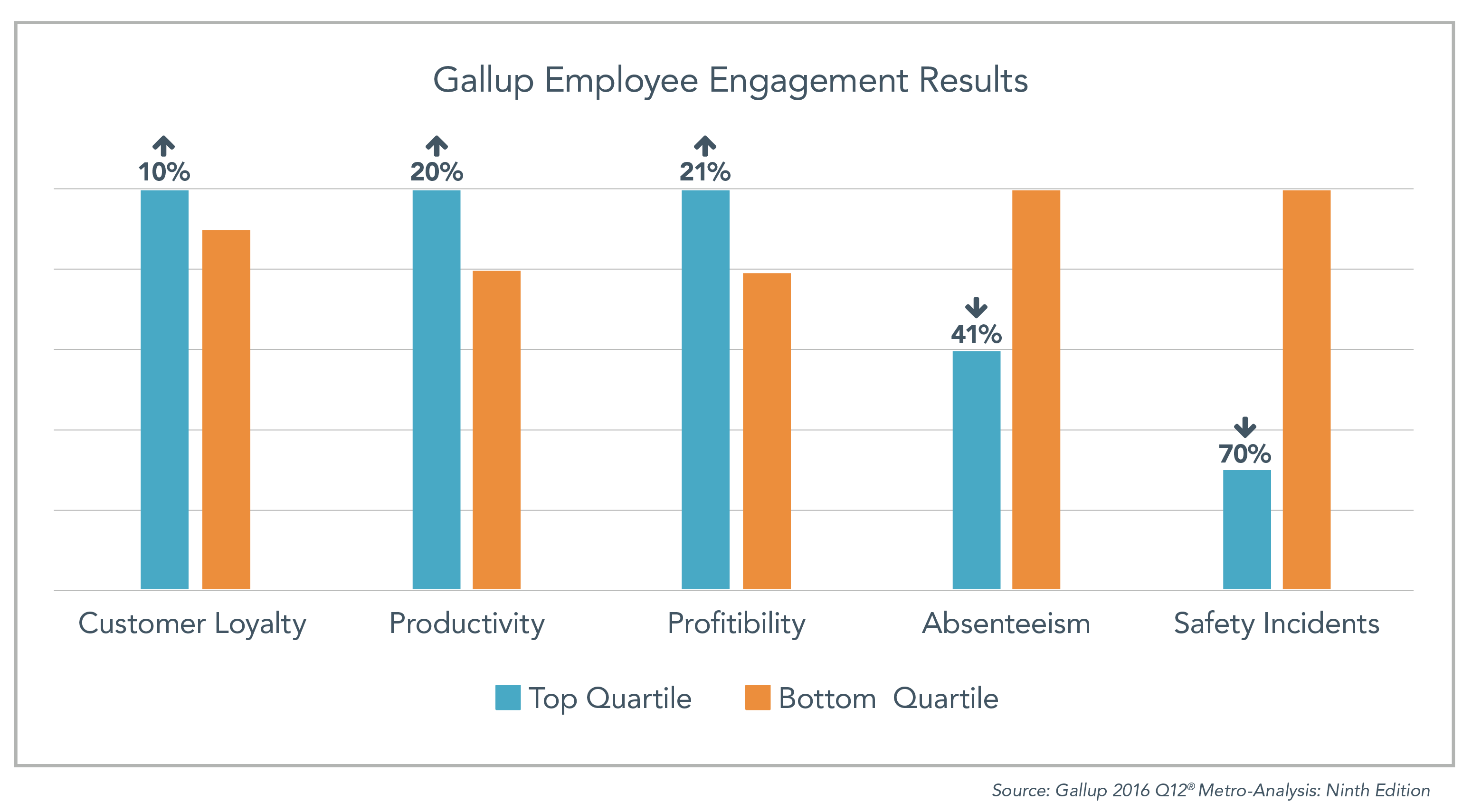The ROI of Employee Engagement

It’s a truism in business that employee engagement is key to employee performance. But what does “employee engagement” even mean? At a high level, think of it as employees making their best effort on the job, fully committed to their company’s values and goals, and contributing to the company’s success. Of course, this definition will vary by company, job, and individual. When you look at the ROI metrics of positively engaged employees, the numbers are convincing. Data recently compiled by Gallup1 across 49 industries indicates that businesses scoring in the top quartile in employee engagement surveys significantly outperform those in the lowest quartile.
The research shows that companies in the top quartile experience 10% greater customer loyalty, 20% higher productivity, and 21% greater profitability than their peers in the bottom quartile. In addition, companies with better employee engagement have 41% lower absenteeism and a staggering 70% fewer safety incidents (see chart). Clearly, employee engagement impacts the bottom line.

The cost of employee turnover
Another often overlooked ROI impact of improved employee engagement is increased workforce retention. Longer-term employees have a bank of critical knowledge, whether through training or on-the-job experience, that cannot be discounted. When employees leave, they take that knowledge with them, and it has a cost.
The Society for Human Resource Management estimates that companies pay about $4,000 in direct and indirect costs to replace a worker making $24,000 per year.2 In high-turnover industries such as food manufacturing and grocery, $4,000 per hire adds up. It makes both operational and financial sense to retain experienced employees.
So, what do the researchers tell us about employee engagement and its effect on turnover? Gallup research shows that in high-turnover industries, successful employee engagement efforts reduce employee turnover by 25%.3 That reduction has a significant bottom-line benefit: in a company employing 1,000 workers with a 50% historical turnover rate, an effective employee engagement program can reduce annual turnover costs by $500,000.
Building a positive employee engagement model
Many factors can drive employee engagement, including company culture, work environment, wages and benefits, and of course the relationships the employee has with his or her coworkers and supervisors.
Employees also stay engaged when they clearly understand their job responsibilities and have the confidence to make the right decisions. For example, one contract food manufacturer employing more than 600 workers was challenged by training inconsistencies and no clear process for filling a growing number of specialized positions. The company believed that committed frontline employees and supervisors were fundamental to the success of its business. So it engaged with its employees by offering leadership development programs for hourly workers. The company invested in an enterprise-wide employee learning program and leveraged the accumulated skills of its longer-tenured workers to create a pipeline into supervisory roles.
Another manufacturer of packaged organic and natural foods turned to a similar training solution, coupling it with a comprehensive coaching program. The combination resulted in accelerated onboarding and enhanced worker-supervisor interaction and dialogue.
In an industry with high turnover, engaging your employees by investing in their growth might seem like a luxury. But the bottom-line impact of an engaged, committed frontline team will pay off for your company—now and into the future.
Sources:
- Gallup, The Relationship Between Engagement at Work and Organizational Outcomes 2016 Q12® Meta-Analysis: Ninth Edition (April 2016), p. 29 http://www.gallup.com/services/191558/q12-meta-analysis-ninth-edition-2016.aspx
- Society for Human Resource Management, “Average Cost-per-Hire for Companies Is $4,129,”(press release, August 3, 2016) https://www.shrm.org/about-shrm/press-room/press-releases/pages/human-capital-benchmarking-report.aspx
- Gallup, p. 29






